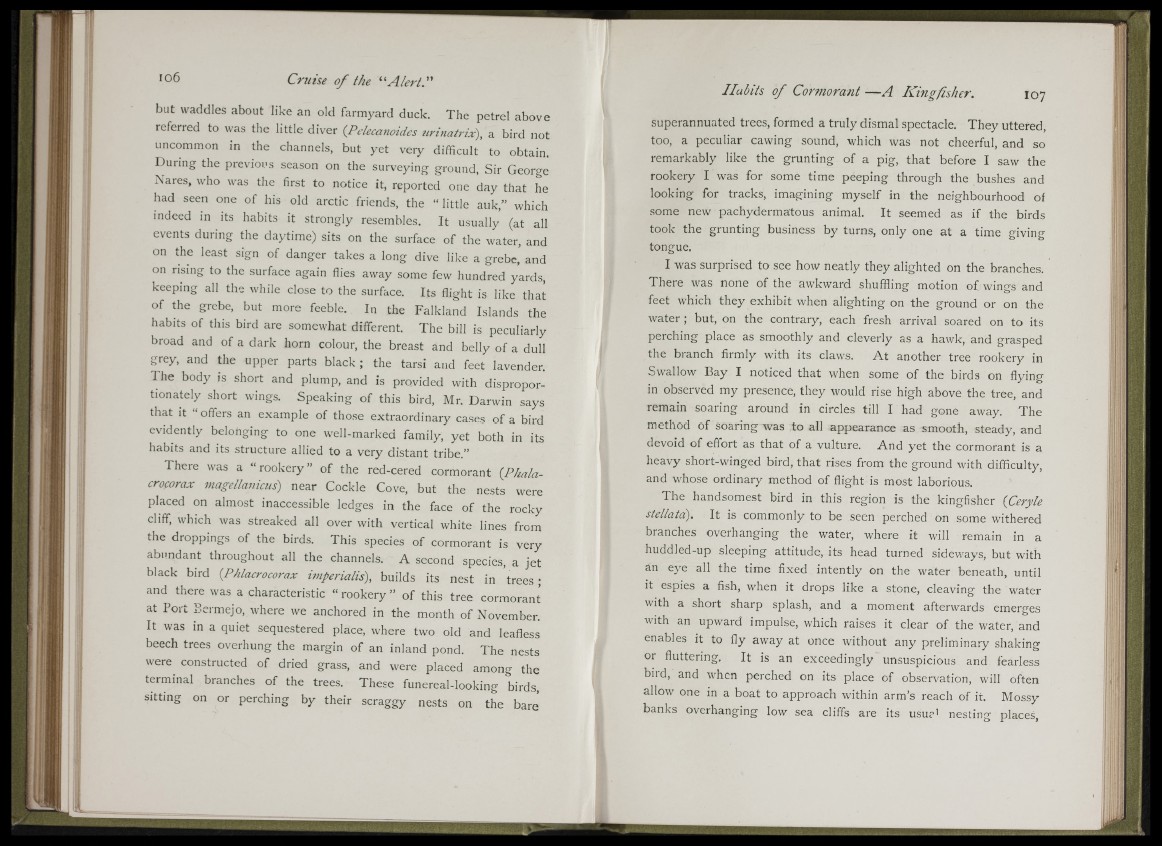
II III
1^'
Ifj
HK
but waddles about like an old farmyard duck. The petrel above
referred to was the little diver {Pelecanoides urinatrix), a bird not
uncommon in the channels, but yet very difficult to obtain.
During the previous season on the surveying ground, Sir George
Nares, who was the first to notice it, reported one day that he
had seen one of his old arctic friends, the “ little auk,” which
indeed in its habits it strongly resembles. It usually (at all
events during the daytime) sits on the surface of the water, and
on the least sign of danger takes a long dive like a grebe’ and
on rising to the surface again flies away some few hundred yards,
keeping all the wlnle close to the surface. Its flight is like that
of the grebe, but more feeble. In the Falkland Islands the
habits of tliis bird are somewhat different. The bill is peculiarly
broad and of a dark horn colour, the breast and belly of a dull
grey, and the upper parts black; the tarsi and feet lavender.
Ih e body is short and plump, and is provided with disproportionately
short wings. Speaking of this bird, Mr. Darwin says
that it “ offers an example of those extraordinary cases of a bird
evidently belonging to one well-marked family, yet both in its
habits and its structure allied to a very distant tribe.”
There was a “ rookery” of the red-cered cormorant {Phala-
crocorax viagellanicus) near Cockle Cove, but the nests were
placed on almost inaccessible ledges in the face of the rocky
chff, which was streaked all over with vertical white lines from
the droppings of the birds. This species of cormorant is very
abundant throughout all the channels. A second species, a jet
black bird {Phlacrocorax imperialis), builds its nest in ’trees;
and there was a characteristic “ rookery ” of this tree cormorant
at Port Bermejo, where we anchored in the month of November.
It was in a quiet sequestered place, where two old and leafless
beech trees overhung the margin of an inland pond. The nests
were constructed of dried grass, and were placed among the
terminal branches of the trees. These funereal-looking birds,
sitting on or perching by their scraggy nests on the bare
Habits o f Cormorant — A Kingfisher. 107
' •«
Í: IlMI
lim
superannuated trees, formed a truly dismal spectacle. They uttered,
too, a peculiar cawing sound, which was not cheerful, and so
remarkably like the grunting of a pig, that before I saw the
rookery I was for some time peeping through the bushes and
looking for tracks, imagining myself in the neighbourhood of
some new pachydermatous animal. It seemed as if the birds
took the grunting business by turns, only one at a time giving
tongue.
I was surprised to see how neatly they alighted on the branches.
There was none of the awkward shuffling motion of wings and
feet which they exhibit when alighting on the ground or on the
water ; but, on the contrary, each fresh arrival soared on to its
perching place as smoothly and cleverly as a hawk, and grasped
the branch firmly with its claws. A t another tree rookery in
Swallow Bay I noticed that when some of the birds on flying
in observed my presence, they would rise high above the tree, and
remain soaring around in circles till I had gone away. The
method of soaring was to all appearance as smooth, steady, and
devoid of effort as that of a vulture. And yet the cormorant is a
heavy short-winged bird, that rises from the ground with difficulty,
and whose ordinary method of flight is most laborious.
The handsomest bird in this region is the kingfisher [Ceryle
stellata). It is commonly to be seen perched on some withered
branches overhanging the water, where it will remain in a
huddled-up sleeping attitude, its head turned sideways, but with
an eye all the time fixed intently on the water beneath, until
it espies a fish, when it drops like a stone, cleaving the water
with a short sharp splash, and a moment afterwards emerges
• 1
with an upward impulse, which raises it clear of the water, and
enables it to fly away at once without any preliminary shaking
or fluttering. It is an exceedingly unsuspicious and fearless
bird, and when perched on its place of observation, will often
allow one in a boat to approach within arm’s reach of it. Mossy
banks overhanging low sea cliffs are its usue' nesting places.
l i i!P
■ i
iiii'!